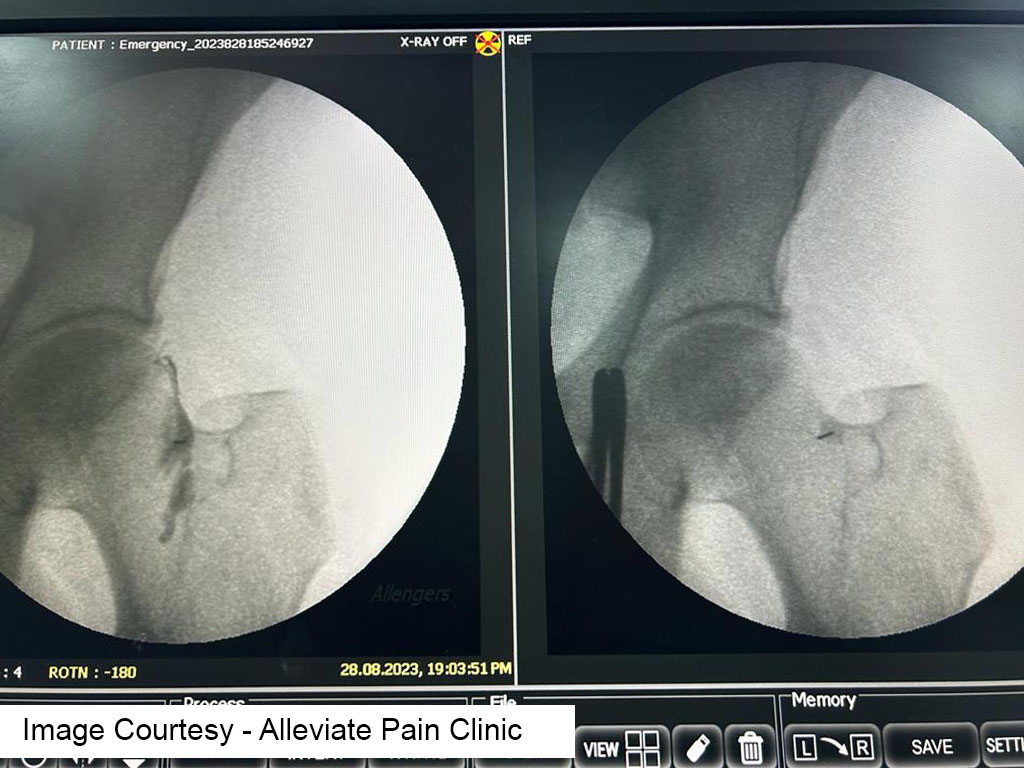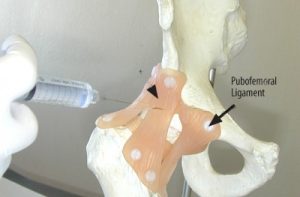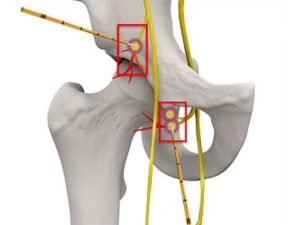Introduction
Hip arthritis, a degenerative joint condition characterized by inflammation and deterioration of the hip joint, can significantly impact one’s quality of life. While surgery has been a common treatment approach, advances in regenerative medicine and image-guided therapies offer promising non-surgical alternatives. In this blog, we will explore innovative image-guided treatments—Platelet-Rich Plasma (PRP), Mesenchymal Stem Cells (MSCs), Prolotherapy, Viscosupplementation, Radiofrequency Ablation (RF Ablation) and explore evidence-based non-surgical approaches, including physiotherapy exercises for hip joint strengthening, modalities such as IFT, TENS, and ultrasound, hydrotherapy, and ozone injection therapy that aim to manage pain and improve function for individuals dealing with hip arthritis.
What are hip arthritis symptoms?
Hip arthritis typically presents with persistent pain in the groin, outer thigh, or buttocks. The discomfort is often worse in the morning or after periods of inactivity. As the condition progresses, stiffness in the hip joint can limit mobility, making daily tasks like walking, bending, or climbing stairs difficult. Patients may also notice a grinding or clicking sensation during joint movement, along with swelling and tenderness around the hip. Pain may radiate down the thigh and intensify with weight-bearing activities. Over time, reduced range of motion and muscle weakness can lead to a noticeable limp.
Recognising these signs early allows for more effective intervention, including non-surgical hip pain treatment strategies that preserve joint function and reduce inflammation. Understanding these symptoms is the first step towards seeking timely and appropriate care, including options such as hip cartilage repair without surgery for long-term relief and improved mobility.
What causes hip arthritis?
Hip arthritis is most commonly caused by osteoarthritis, which results from the gradual wear and tear of the cartilage cushioning the hip joint. Over time, the loss of this protective cartilage leads to bone-on-bone friction, causing pain and inflammation. Other causes include rheumatoid arthritis, an autoimmune condition that attacks the joint lining, and post-traumatic arthritis, which develops after an injury to the hip. Genetic predisposition, obesity, and repetitive stress on the hip joint from certain occupations or sports can also increase the risk.
In younger patients, developmental disorders such as hip dysplasia can contribute to early-onset arthritis. Early diagnosis is crucial to manage symptoms and slow the progression of the disease. When cartilage damage is identified in its initial stages, options like hip cartilage repair without surgery may be considered.
Understanding the root cause enables patients to explore holistic solutions, including treatment for hip arthritis without surgery for better joint health.
9 Treatment Options for Hip Arthritis
Patients seeking treatment for hip arthritis without surgery have several effective options. These include physiotherapy, anti-inflammatory medications, weight management, regenerative therapies, platelet-rich plasma (PRP) injections, image-guided hip joint injections, lifestyle modifications, activity adjustment, and targeted supplements.
At Alleviate Pain Clinic, our focus is on providing non-surgical hip pain treatment to relieve discomfort and enhance mobility without invasive procedures.
Platelet-Rich Plasma (PRP)
Intrarticular Platelet Rich Plasma Injection done under fluoroscopyPRP therapy harnesses the healing properties of platelets to promote tissue regeneration and reduce inflammation. In image-guided PRP treatments for hip arthritis, the injection is precisely guided to the affected joint, ensuring optimal placement. Research suggests that PRP can stimulate the growth of cartilage and modulate inflammatory processes, offering pain relief and improved joint function.

Mesenchymal Stem Cells (MSCs)
Mesenchymal stem cells, obtained from the patient’s own bone marrow or adipose tissue, possess the potential to differentiate into various cell types, including those essential for joint repair. Image-guided injection of MSCs directly into the hip joint has shown promise in reducing pain and improving function for individuals with hip arthritis. The precise placement of MSCs under guidance enhances the therapeutic impact of this regenerative approach.
Prolotherapy
Anatomy model illustration of the anterior hip ligaments. This picture demonstrates a Prolotherapy injection of the anterior portion of the iliofemoral ligament and pubofemoral ligament from the front of the hip.

Prolotherapy, a regenerative injection therapy, involves the injection of a solution to stimulate tissue repair and strengthen ligaments. Image guidance ensures accurate delivery of the solution to the affected areas of the hip joint, promoting stability and reducing pain. Prolotherapy can be particularly effective in addressing the underlying causes of arthritis, such as joint laxity and instability
Viscosupplementation
Viscosupplementation involves injecting hyaluronic acid into the joint to enhance lubrication and reduce friction between bones. This procedure, guided by imaging techniques, is designed to alleviate pain and improve joint mobility. Studies have indicated that viscosupplementation can provide sustained relief for hip arthritis patients, enhancing their overall quality of life
Radiofrequency Ablation (RF Ablation)

RF ablation is a minimally invasive procedure that uses heat generated by radiofrequency energy to disrupt pain signals from nerve tissues. In image-guided RF ablation for hip arthritis, the targeted nerves are precisely identified, providing effective pain management without the need for surgery. This technique offers a viable option for individuals seeking long-term relief from arthritis-related pain
Physiotherapy Exercises for Hip Joint Strengthening
Physiotherapy exercises are a cornerstone in the non-surgical management of hip arthritis. Strengthening the muscles around the hip joint helps provide stability, reduce pain, and improve functionality. Key exercises include
- Hip Flexor Stretch : Helps alleviate tightness in the front of the hip.
- Straight Leg Raises : Targets hip flexors and abductors.
- Clamshells : Strengthens the hip abductor muscles.
- Wall Squats : Engages quadriceps and hip muscles for overall support.
These exercises, when performed under the guidance of a physiotherapist, can contribute to better joint mechanics and enhanced quality of life
Modalities: IFT, TENS, and Ultrasound
- Interferential Therapy (IFT) : IFT involves the use of low-frequency electrical currents to stimulate nerves and reduce pain. Studies have shown its effectiveness in managing pain associated with hip arthritis by promoting circulation and reducing muscle spasm.
- Transcutaneous Electrical Nerve Stimulation (TENS) : TENS delivers low-voltage electrical currents to the skin, disrupting pain signals. Research supports its use in hip arthritis, providing a non-invasive method for pain relief.
- Ultrasound Therapy : Ultrasound waves penetrate deep tissues, promoting circulation and reducing inflammation. This modality can be beneficial in managing pain and stiffness associated with hip arthritis.
Hydrotherapy
Hydrotherapy, or water-based exercises, offers a low-impact environment for individuals with hip arthritis. The buoyancy of water reduces stress on the joints while allowing for effective strengthening and flexibility exercises. Hydrotherapy has been shown to improve joint mobility and reduce pain in individuals with hip arthritis

Ozone Injection Therapy
Ozone injection therapy involves injecting ozone gas into the affected joint, aiming to reduce inflammation and promote tissue healing. Research suggests that ozone therapy can be a safe and effective adjunctive treatment for hip arthritis, providing symptomatic relief and potentially slowing disease progression
FAQs
Yes, walking is beneficial as it keeps the hip joint mobile, reduces stiffness, and helps maintain strength. Low-impact walking can support non-surgical hip arthritis treatment plans.
Foods rich in omega-3 fatty acids, antioxidants, and anti-inflammatory properties, such as leafy greens, berries, turmeric, and fatty fish can help manage inflammation and support joint health.
Results from non-surgical treatments like physical therapy or injections may be noticeable within a few weeks, but full benefits often require consistent treatment over 6–12 weeks.
Surgery may be considered when non-surgical hip pain treatment fails to relieve symptoms, and pain or mobility issues begin to significantly impact daily life and joint function.
Yes, weight loss reduces stress on the hip joint, lessens inflammation, and enhances the effectiveness of non-surgical treatments for hip arthritis management and symptom relief.
Conclusion
Image-guided treatments represent a significant leap forward in the non-surgical management of hip arthritis. PRP, MSCs, prolotherapy, viscosupplementation, RF ablation and ozone injection when administered with precision under imaging guidance, offer targeted relief, promoting tissue repair, reducing inflammation, and improving overall joint function. Non-surgical interventions, such as physiotherapy exercises, modalities like IFT, TENS, and ultrasound and hydrotherapy offer a holistic approach to managing hip arthritis. These evidence-based therapies aim to enhance joint function, reduce pain, and improve overall quality of life. Combining these non-invasive treatments, guided by the expertise of healthcare professionals such as At Alleviate, can empower individuals to actively participate in their journey towards better hip health.
References
- Patel S, Dhillon MS, Aggarwal S, Marwaha N, Jain A. Treatment with platelet-rich plasma is more effective than placebo for knee osteoarthritis: a prospective, double-blind, randomized trial. Am J Sports Med. 2013;41(2):356-364.
- Emadedin M, Ghorbani Liastani M, Fazeli R, et al. Long-term follow-up of intra-articular injection of autologous mesenchymal stem cells in patients with knee, ankle, or hip osteoarthritis. Arch Iran Med. 2015;18(6):336-344.
- Rabago D, Nourani B. Prolotherapy for osteoarthritis and tendinopathy: a descriptive review. Curr Rheumatol Rep. 2017;19(12):79.
- Jüni P, Reichenbach S, Trelle S, et al. Efficacy and safety of intraarticular hylan or hyaluronic acids for osteoarthritis of the knee: a randomized controlled trial. Arthritis Rheum. 2007;56(11):3610-3619.
- McCormick ZL, Korn M, Reddy R, et al. A prospective randomized trial of prognostic genicular nerve blocks to determine the predictive value for the outcome of cooled radiofrequency ablation for chronic knee pain due to osteoarthritis. Pain Med. 2018;19(8):1628-1638.
- Thorborg K, Holmich P, Christensen R, Petersen J, Roos EM. The Copenhagen Hip and Groin Outcome Score (HAGOS): development and validation according to the COSMIN checklist. Br J Sports Med. 2011;45(6):478-491.
- Fatoye F, Yeowell G, Macmillan F. Interferential therapy electrode placement technique in the management of hip osteoarthritis: a crossover randomized controlled trial. Physiotherapy. 2017;103(1):70-77.
- Johnson MI, Paley CA, Howe TE, Sluka KA. Transcutaneous electrical nerve stimulation for acute pain. Cochrane Database Syst Rev. 2015;6:CD006142.
- Loyola-Sánchez A, Richardson J, Beattie KA, Otero-Fuentes C, Adachi JD, MacIntyre NJ. Effect of low-intensity pulsed ultrasound on the cartilage repair in people with mild to moderate knee osteoarthritis: a double-blinded, randomized, placebo-controlled pilot study. Arch Phys Med Rehabil. 2012;93(1):35-42.
- Bartels EM, Juhl CB, Christensen R, Hagen KB, Danneskiold-Samsøe B, Dagfinrud H, Lund H. Aquatic exercise for the treatment of knee and hip osteoarthritis. Cochrane Database Syst Rev. 2016;3(3):CD005523.
- Önen Ünsalver B, Güneri B, Karagülle MZ, et al. Intra-articular ozone or hyaluronic acid injection: Which one is superior in patients with knee osteoarthritis? A 6-month randomized clinical trial. J Back Musculoskelet Rehabil. 2021;34(2):327-336.





